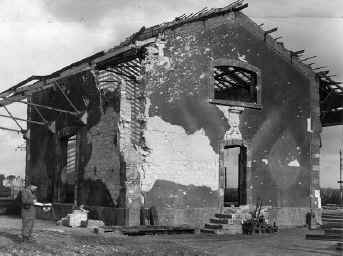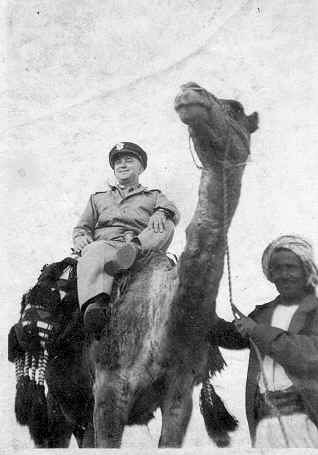I was asked by the organizers of the 1st Radio and Broadcast Unit reunion to write a short biographical sketch of my father for their unit history. This is for those who may have known Dad at different times in his life, but never knew the full story. He was never one to tout his own accomplishments, so I have simply listed them here:
John M. Taylor, 1907 - 1987
On the Giza, by the Pyramids - 1942
Marion Taylor, as he was known to his family, was born and raised on a tobacco farm in Robeson County, North Carolina, and worked his way through college waiting tables in the school cafeteria, driving a Coca-Cola delivery truck and as a member of the North Carolina National Guard, serving summers as a powder monkey on the Fort Monroe coast artillery fortifications protecting the mouth of the Chesapeake Bay. He graduated from North Carolina State University at Raleigh with a Bachelor of Science in Agricultural Education and a commission as a 2nd Lieutenant of Infantry in the Army Reserve. He then taught high school agriculture in his home county of Robeson County, North Carolina, where he was introduced to his future wife, Mary Hardin, by a cousin. They were married by the Justice of the Peace in Dillon, South Carolina. He continued to teach, moving to Waxhaw, North Carolina where their first son, John Jr., was born, until called to active duty in 1940.

After the end of World War II he left active duty as a Major and returned to North Carolina, the farm and teaching agriculture and shop at Ellerbe, North Carolina. He was very active in the post-war Veteran education programs and instrumental in developing the Ellerbe High School paper to national recognition, even warranting a mention on the Standard Oil road maps of the day. Son Richard Allen was born during this time in Ellerbe. Meanwhile, Taylor maintained his reserve status and earned a promotion to Lieutenant Colonel in the Army Reserves. In the summer of 1947 he attended the Transportation School Officers Associate Course at Fort Eustis, Virginia.
Taylor was recalled to active duty as a Major in 1948 and initially served as the Regimental Operations Officer with the 10th Infantry Regiment, 5th Division, at Fort Jackson, South Carolina where their third son, Henry Thomas was born. Taylor was then was transferred to Headquarters, Third Army, where he initially served in the Transportation Division and was asked to use his expertise as a teacher with an assignment as advisor to the Reserve Officers Training Corps at Atlanta’s Fulton High School.
In October 1950 he was selected to attend an inaugural Psychological Warfare course at George Washington University and establish a psychological warfare element in the Third Army staff. He then attended the Psychological Warfare Unit Officer Course at Fort Riley, Kansas in 1951 and returned to the Third Army where he continued the development of psychological warfare concepts. BG McClure, then the Army Chief of Psychological Warfare, recognized Taylor in a letter of commendation for his direction of the psychological warfare aspects of the Southern Pine Exercises in the fall of 1951, a test of newly emerging concepts to be employed in the Korean Conflict. Taylor continued to serve as the Third Army Psychological Warfare Officer, anticipating assignment to the Far East and the Korean Conflict.
Taylor received a setback in 1952 when the medical staff at Fort Benning removed a kidney, a condition that proscribed assignment to combat zones, but allowed his assignment to Tokyo with the 1st Radio, Broadcasting and Leaflet Group as the Operations Officer in June of 1952 . His wife, Mary, and three sons joined him to live on the economy in Setagaya-ku, Tokyo in November of 1952. After about six months learning the ways of Japan they moved to government quarters in Grant Heights, site of what was originally a Japanese air base, and Taylor was assigned the position of 1st RB&L Group Executive Officer. In addition to his military duties, Taylor introduced the Carolina touch to farming on his small garden plot where he raised genuine collard greens that pleased many of the other Southerners serving in the Tokyo area. Taylor served with the 1st RB&L until the retirement of the unit colors at the end of 1954.
Upon his reassignment to the States, Taylor was further assigned as senior advisor to the Savannah, Georgia Reserve District. He left active duty for the final time in 1957 when he again returned to farming and teaching agriculture and shop at his old school in Ellerbe. He was recognized as a stalwart of the community by the vets he had taught upon their return from World War II and several following generations of high school students over his twenty-six year span of teaching at Ellerbe High School. His sons continued on to college, John to Georgia Tech, Richard to the University of North Carolina, and Tom to North Carolina State University, with the summers devoted to helping raise tobacco on the family farm. Upon his final retirement from Ellerbe High School in 1972, Taylor was presented with a plaque inscribed with a quote from the February 15, 1932 issue of The Robesonian, Taylor’s home-town paper: "Attending strictly to business, a young man without bad habits, and with the highest type of character, he should be an inspiration to other men…"
After retirement, he and Mary traveled with friends and he gardened, maintaining his ties with the farm he loved as much as teaching. Mary became famous for her cooking, especially the pies and cakes of all kinds. They were very active in community affairs, especially with their church and volunteer work with the Lions Club. Over the years they were blessed with six grandchildren, and the great-grandchildren list is still growing. And Mary continued to cook for them all whenever she got the chance.
John Taylor died due to a heart condition in 1987, followed by his wife Mary in 2005. His son John, Jr. continued in the Army, serving in Vietnam, Germany, and with the 101st Airborne Division and US Central Command, then retired to the telecommunications industry. He is now an author of several novels. Richard, a published poet, is with the Hendrick Automotive Group. Tom served with the 82nd Airborne Division and in Germany, and now is an engineer with Huber Technology, Inc. (A 2019 update - time has finally caught up with the Taylor boys - all are now retired.)
In Memoriam
John M. Taylor, Jr.
January 30, 2002
Postscript, July, 2004
With the death of Mary Hardin Taylor, John's devoted wife, just four days before her ninetieth birthday, I am reminded to add that all the accomplishments of any of us who have served in the military are equaled, perhaps surpassed by the sacrifices of our wives, my mother, Mary in particular. Raising kids with a minimum of money and, especially in the Twentieth Century, a minimum of help from anywhere but the immediate family during the many separations and frequent moves, brought forth the strength and fortitude reminiscent of frontier wives.
God bless Mom and Dad.
JMTjr
